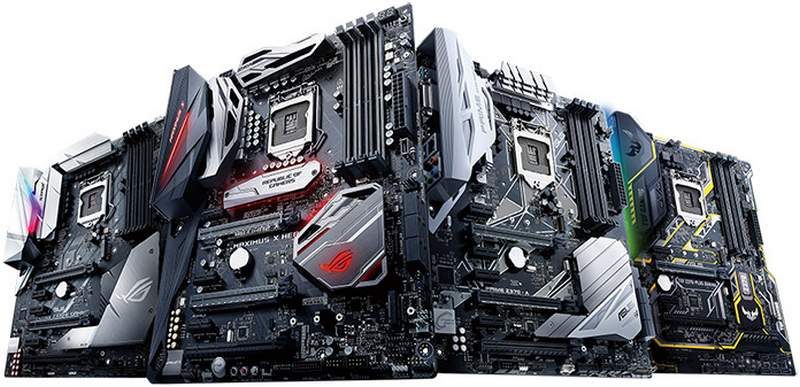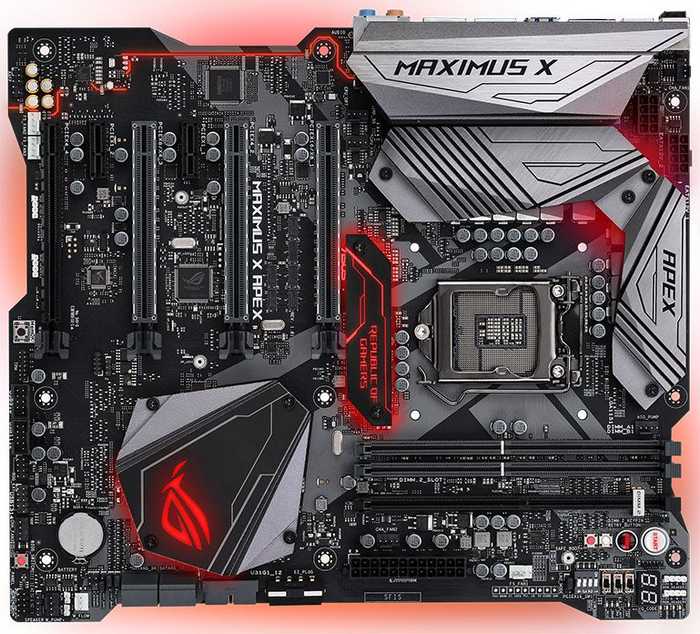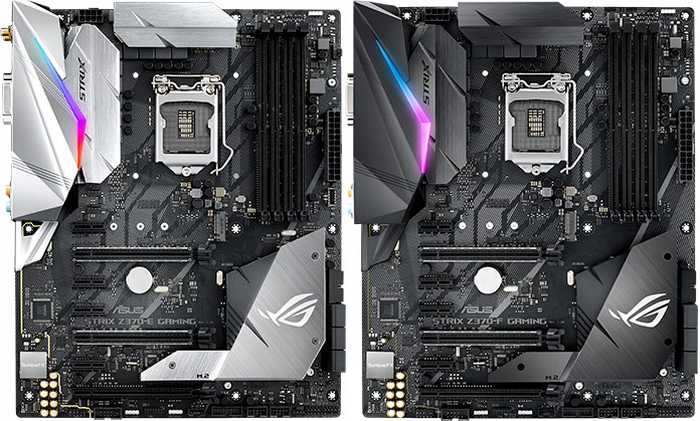ASUS Introduces Intel Z370 Motherboard Lineup
Ron Perillo / 7 years ago
On October 5, users will finally be able to buy the new Intel 8th-generation Core processors. To coincide with this release, ASUS is introducing 11 new Z370-chipset models to choose from. That is more than twice as many options as their competitors are offering. Since Intel is also skipping the affordable B360 and H370 chipset boards on launch day, these new Z370 models will encompass budget priced models all the way to the top-end Maximus X Apex.
ASUS RoG Maximus Motherboards
At the very top sits the Maximus X Apex. This motherboard has the weird non-typical edges seen in the Maximus IX Apex. In fact, they look almost identical. The Maximus X Apex however adds more fan headers and more RGB LED headers. It also adds an IO cover and the VRM chipset heatsink has airflow channels for better cooling. It also retains that third DIMM slot for ASUS’ DIMM.2 feature. It supports dual SLI and up to four-way CrossFireX. Aside from only have two DIMM slots, it also has less SATA3 6G ports than most at only four. This is also the only motherboard in ASUS’ entire Z370 lineup that is equipped with Aquantia 5G Ethernet.
Other than the Apex, the Maximus X Hero is also available. It lacks the DIMM.2 feature but it has plenty of on-board overclocking features as well. Users get three RGB LED headers (one addressable) plus embedded LEDs on the chipset, IO cover and M.2 heatshield. It will be available with a Wi-Fi AC variant and it is the only motherboard in ASUS’ stable that has ESS Sabre DAC with its SupremeFX S1220 (ALC1220) audio subsystem. It supports three-way CrossFireX and two-way SLI.
ASUS TUF Z370 Motherboards
 ASUS is offering their Z370 TUF Gaming motherboards in two options: TUF Z370-Pro and TUF Z370-Plus. Both have a black/gray with yellow trim aesthetic and have a unique cut-off edge on the right side, similar to the Maximus X Apex. These motherboards prioritize durability above features and have the longest warranty in the lineup; 5-years in North America and Taiwan. The Z370-Pro gaming is the higher-end of the two, having three PCIe x16 and three PCIe x1 slots available. The Z370-Plus on the other hand has two PCIe x16 slots and four PCIe x1 slots. Only the Z370-Pro gaming supports two-way SLI, while the Z370-Plus Gaming only supports two-way CrossFireX.
ASUS is offering their Z370 TUF Gaming motherboards in two options: TUF Z370-Pro and TUF Z370-Plus. Both have a black/gray with yellow trim aesthetic and have a unique cut-off edge on the right side, similar to the Maximus X Apex. These motherboards prioritize durability above features and have the longest warranty in the lineup; 5-years in North America and Taiwan. The Z370-Pro gaming is the higher-end of the two, having three PCIe x16 and three PCIe x1 slots available. The Z370-Plus on the other hand has two PCIe x16 slots and four PCIe x1 slots. Only the Z370-Pro gaming supports two-way SLI, while the Z370-Plus Gaming only supports two-way CrossFireX.
Otherwise, both boards use a Realtek ALC887 HD audio codec, use Intel Gigabit LAN, have two M.2 slots, six SATA3 6G ports and two USB 3.1 Type-A ports. However, the Z370-Plus has one feature advantage that the Z370-Pro lacks: RGB LED strip header support.
ASUS ROG Strix Z370-E and Z370-F
Five motherboards comprise of the ROG Strix line. Unlike the regular ROG boards which are designed for overclockers, the ROG Strix line is meant more for mainstream Republic of Gamers users. They all feature one-click system tuning via 5-way optimization, SupremeFX S1220 audio and comes in a variety of colors and sizes. Starting with the ROG Strix Z370-E and ROG Strix Z370-F motherboards, users get M.2 cooling which is part of the PCH heatsinks, armored PCIe x16 slots and more. These two are actually nearly identical feature-wise, although one is physically lighter while the other has a darker color theme. The only major difference is that the Z370-E comes with a 2×2 802.11ac WiFi MU-MIMO for networking. The Z370-F only has the same Intel i219-V wired Gigabit Ethernet that it shares with the Z370-E. Also, the Z370-E has a front USB 3.1 Gen 2 header.
ASUS ROG Strix Z370-H
The ROG Strix Z370-H has a bit more red on it than the Z370-E and Z370-F. It actually looks like a retro ROG motherboard because of this. This board is meant more for those with entry level aspirations, providing all the essentials for the Z370 platform. This includes dual M.2, an dual-SLI/CrossFireX support. It uses the same Intel i219-V Gigabit Ethernet controller for networking and has the same SupremeFX S1220A implementation for the audio subsystem. It lacks the ASUS Aura RGB LED support however.
ASUS ROG Strix Z370-G
For micro-ATX enthusiasts, the ROG Strix Z370-G is a nice, compact option. It comes with the same 802.11ac WiFi feature as the Z370-E and has the same Intel i219-V Gigabit Ethernet as the rest of the Strix Z370 family. Despite the compact size, it supports two-way SLI/CrossFireX and even has dual M.2 slots. ASUS had to get creative to be able to fit two because of the size. So the second M.2 slot is actually a vertical slot right below the 24-pin PSU connector cable. It does not come with any RGB LED headers but the chipset heatsink has embedded Aura RGB LED.
ASUS ROG Strix Z370-I
 The ROG Strix Z370-I on the other hand is for even smaller form factor enthusiasts. It is a mini-ITX mainboard but it shares many of the Z370-G’s features. Excluding the SLI/CrossfireX support of course since there is only a single PCIe x16 slot available. It has the same Intel i219-V Gigabit Ethernet and 2×2 802.11ac WiFi MU-MIMO built in, as well as the SupremeFX S1220A audio solution. Although it actually has an RGB LED digital header available for users who want to hook up an addressable LED strip. The entire right side edge also lights up with RGB LEDs, customizable via ASUS Aura software. In terms of storage, it has two M.2 NVMe PCIe x4 storage slots. One is right above the PCIe x16 slot and one is behind the motherboard. It has four SATA3 6G ports and even has a USB 3.1 Gen 2 front panel header on-board.
The ROG Strix Z370-I on the other hand is for even smaller form factor enthusiasts. It is a mini-ITX mainboard but it shares many of the Z370-G’s features. Excluding the SLI/CrossfireX support of course since there is only a single PCIe x16 slot available. It has the same Intel i219-V Gigabit Ethernet and 2×2 802.11ac WiFi MU-MIMO built in, as well as the SupremeFX S1220A audio solution. Although it actually has an RGB LED digital header available for users who want to hook up an addressable LED strip. The entire right side edge also lights up with RGB LEDs, customizable via ASUS Aura software. In terms of storage, it has two M.2 NVMe PCIe x4 storage slots. One is right above the PCIe x16 slot and one is behind the motherboard. It has four SATA3 6G ports and even has a USB 3.1 Gen 2 front panel header on-board.
ASUS Z370 Prime Motherboards
The last two motherboards are from ASUS’ Prime series comprising of the Prime Z370-A and Prime Z370-P. Just judging from the looks, it is obvious that the Prime Z370-P is the cheaper board. Having push-pins for the VRM heatsink and only on top of the CPU VRM MOSFETs. Nonetheless, it supports DDR4 up to 3866MHz and has room for up to two M.2 NVMe PCIe x4 SSDs. Its Gigabit Ethernet and audio is from Realtek and it lacks any Aura RGB LED features.
 The Prime Z370-A looks a lot classier, having a similar design to the Z370-E/F boards. This includes the integrated M.2 heatsink with the PCH heatsink. It also has Aura RGB right along the right edge and has an RGB LED header available at the bottom for plugging in LED strips. Unlike the Z370-P, it uses Intel i219-V for the Gigabit Ethernet solution and its Crystal Sound 3 S1220A uses a Realtek ALC1220 HD audio codec. Users can comfortably run dual SLI via its steel reinforced PCIe x16 slots.
The Prime Z370-A looks a lot classier, having a similar design to the Z370-E/F boards. This includes the integrated M.2 heatsink with the PCH heatsink. It also has Aura RGB right along the right edge and has an RGB LED header available at the bottom for plugging in LED strips. Unlike the Z370-P, it uses Intel i219-V for the Gigabit Ethernet solution and its Crystal Sound 3 S1220A uses a Realtek ALC1220 HD audio codec. Users can comfortably run dual SLI via its steel reinforced PCIe x16 slots.



























